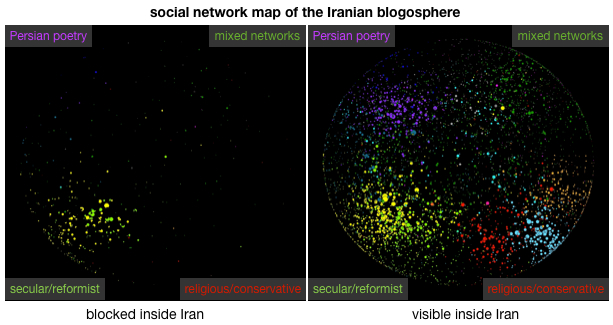A Preview of our forthcoming Iran Blogosphere Study
ONI has documented filtering in Iran in a number of studies over the past four years, demonstrating an increase in the extent of filtering. At the core of the issue is the impact of Internet filtering on the range of viewpoints available to people in countries that practice it. A fundamental problem in developing metrics for assessing filtering is the ‘denominator’ problem—it is difficult to define the relevant population of websites to study. We are currently exploring some interesting empirical approaches that may help in this regard. Later this spring, we will publish the results of a new study of the blogosphere in Iran that combines the empirical testing of Internet filtering with social network analysis. We present here a brief preview of the study.

The figures above show ONI data on Internet blocking in Iran projected onto a social network map of the Iranian blogosphere. The network map (courtesy Morningside Analytics) plots the top 6,000 Persian language blogs according to the links among them. In the diagram, every dot represents a blog. The size of the dot indicates the number of links received from other blogs in the network. Blogs are positioned by a “physics model” algorithm, in which a general force tries to move all blogs apart while a specific force draws together linked pairs of blogs, as though they were connected by a spring. In the resulting map, the Iranian blogosphere clusters into densely connected “network neighborhoods” of bloggers, who tend to be united by common interests and attitudes. The color of the blogs represents an analysis of each blog’s entire profile of links to all online resources (not just to other blogs but to such things as news sites and civil society organizations as well). Thus blogs that link to similar things are assigned to the same color-coded “attentive cluster.” The yellow and green cluster in the lower-left quadrant of the map contains reformist, secular and expatriate bloggers. The lower-right quadrant features three related clusters of conservative, Islamist bloggers. The upper quadrants contain blogs that are not overtly political, including poets on the left and a scatter of many topics (such as popular music, sports and Zoroastrianism) on the right.
The figure on the right shows blogs that are not blocked, and can be read inside Iran. The figure on the left shows blogs that are blocked, and not visible inside Iran. A couple of observations stand out: 1.) a large majority of the Iranian blogosphere is visible to Iranians; and 2.) most of the blocked blogs are in the “secular/reformist” corner of the network. While it is unsurprising that blogs from this group are disproportionately blocked, it is interesting to note that the majority of these blogs are not blocked. Also, a handful of blogs from religious, pro-regime parts of the network are blocked as well. A preliminary analysis of these indicates content (like anti-Arab bias and discussion of “temporary marriages”) that, while not unfriendly to the Islamic Republic, might nevertheless be embarrassing to it.
In a previous collaboration with Dr. Richard Rogers of Govcom.org, ONI data was used in conjunction with hyperlink analysis and crawling methods similar to what has been undertaken here to discover newly blocked websites.
ONI continues to analyze the content of these blogs, as well as looking in further detail at additional network and text data, to better grasp the nature and consequences of Internet blocking in Iran. Stay tuned for our report in the coming weeks. In the meanwhile, our colleagues at the Internet and Democracy project at the Berkman Center for Internet & Society have just released their own study of the Iranian blogosphere, which examines the social network map in greater detail. Also read about this study here, in yesterday’s New York Times.



